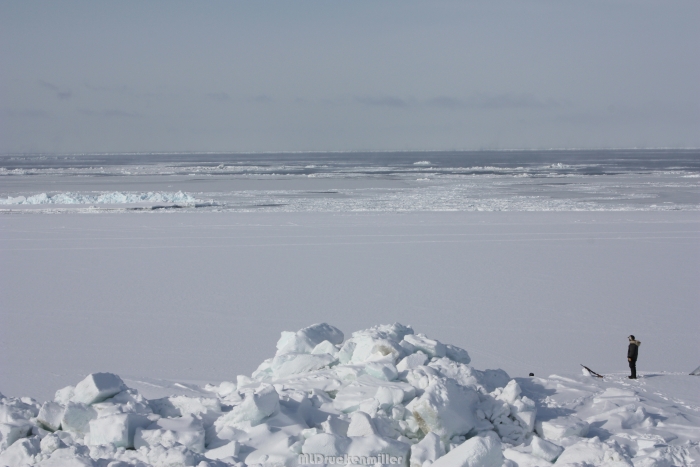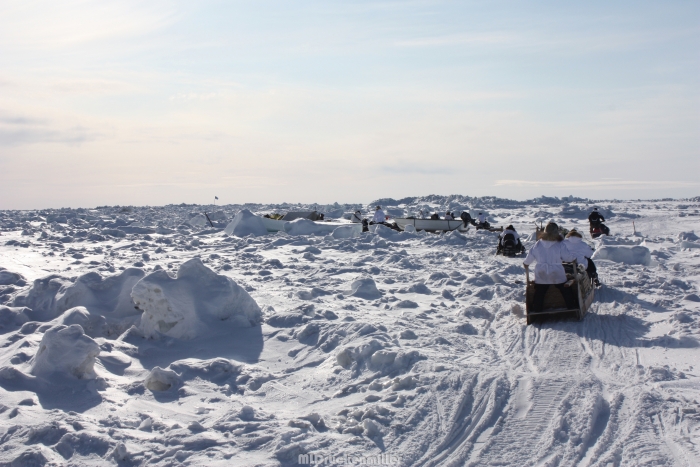By: Karen Brewster, Research Associate, Oral History Program, University of Alaska Fairbanks
The Oral History Program at the University of Alaska Fairbanks has recently completed the Northern Alaska Sea Ice Project Jukebox available online. People who visit the website can access oral history recordings that offer a rich understanding of sea ice and changing conditions in the North. The goals of this jukebox project are to offer long-term observations about sea ice in northern Alaska in order to inform the scientific community's understanding of sea ice over a longer timeframe and through a broader lens than may otherwise be available, and to help the Iñupiaq community share traditional knowledge between generations.

The website includes oral history recordings with 26 residents of the North Slope of Alaska talking about sea ice conditions, observations over time, and changes that are occurring. Included are: interviews recorded from 1978 to 1980 by Dr. Lew Shapiro, Ron Metzner, and Kenneth Toovak for the Geophysical Institute at the University of Alaska Fairbanks (UAF) as part of a study related to potential offshore oil development; interviews recorded from 2008-2009 by Dr. Matthew Druckenmiller as part of his Geophysics PhD project at UAF about sea ice thickness along spring whaling trails offshore of Barrow, Alaska; and recordings made in Barrow in November 2013 by Karen Brewster, Research Associate at Project Jukebox and UAF Geophysics PhD student Oliver Dammann about "unusual" ice conditions in the previous spring and long-term changes experienced by local residents. There is also an interview with sea ice scientist Dr. Lew Shapiro, talking about his 1970s project as well as his research and career in general.
The Sea Ice Project Jukebox also includes links to related material so that users can begin to understand some of the broader scientific and cultural context surrounding sea ice. Available documents include: the report titled Historical References to Ice Conditions Along the Beaufort Sea Coast of Alaska by Lew Shapiro, Ron Metzner, and Kenneth Toovak that is the summation of their interview project; a list of Iñupiaq sea ice terms; some basic diagrams of sea ice features; maps of sea ice trails used by Barrow whalers; and material and websites related to northern Alaska sea ice such as articles, book chapters, the Geophysical Institute's Sea Ice Group and Seasonal Ice Zone Observing Network (SIZONet), and the Historical Sea Ice Atlas.
Through the stories in this project, it is possible to learn about ice conditions in the Beaufort and Chukchi Seas through time. Going back in time like this provides sea ice researchers a longer perspective on which to base their scientific investigations. One can better assess current conditions by knowing what came before. The material also can be useful to social science researchers wanting to learn more about traditional knowledge and cultural practices, as well as those working on issues related to climate change, adaptation, risk taking, and decision making.

By listening to accounts from the 1970s, both similarities and differences between them and what local observers report today are revealed. Analysis of the differences can tell us about changing ice conditions. For example, there is variation in the level of discussion about different ice features. One might notice that pile-ups (called ivu in Iñupiaq) are mentioned much more frequently in the older interviews than they are today. This leads to speculation about why. It could be a result of the purpose of the interview and the nature of the questions being asked. It also could be that in earlier times an ivu was a regular event that locals had to deal with so it was something they thought about and talked about a lot, while they rarely happen today and so Iñupiat do not discuss them at the same rate. This then raises the scientific question of why ivus do not happen as often or in the same way as before. In contrast, in the 2008 to 2013 interviews ice break-off events was a main topic that only rarely appeared in the 1970s interviews. Large ice break-off events seem to be happening now nearly every spring at Barrow during whaling. They are often viewed as a new phenomenon, being the result of thinning ice and changing environmental conditions. However, the oral history demonstrates that drifting out on the ice is not new. For instance, in 1978, Henry Nashaknik described two different incidents in the winter of 1932 when seal hunters were caught on ice that drifted out from Cross Island. They were lost for many days, but returned to shorefast ice when in one case their drifting island came back around, and in the other when the men crossed through shifting ice and building pressure ridges to reach safety.

The oral histories also are useful because of how far back in time they can take us. While the earliest recordings in the project are from 1978, the stories and memories of the elder narrators go back more than 50 years into their youth, and sometimes take us into the previous generation when they are able to relay stories that they heard from parents or grandparents:
- In 1979, Otis Ahkivgak told a story that he says happened in 1890 when the ice piled up so high onto the bluff in Barrow that it toppled onto a sod house killing its occupant.
- Kenneth Toovak relayed a story that tells us something about the ice conditions in the 1930s, when he described seeing ice piled up so high on top of the bluff that he could see it from a mile inland.
- In 2013, Crawford Patkotak related a story he'd heard from his father of a big ice pileup in 1957, when many whalers in Barrow had to run for their lives as the ice—being smashed by heavier incoming ice—broke up around them.
Hearing about what the ice, wind and weather was doing at the time can lead to more investigations of ice dynamics and wind, water, and ice interaction.
We are all keenly aware of the huge changes occurring in the Arctic and with northern sea ice. A commonly heard refrain when talking about sea ice conditions with whalers and hunters today is, "I've never seen it like this before." However, it is interesting to note that even as far back as 1978, some of the people interviewed also mentioned how things were different from before. This challenges current assumptions that conditions were more constant in the past, and that dealing with change is a modern climate change-based phenomenon experienced by those living off the sea ice. The oral history shows that Iñupiat have managed for a long time to live with changing conditions, learn from the past, and adapt.
Scientists like to be able to take a long-term view. Such a perspective is especially critical during this period of intense research related to climate change when scientists are trying to understand what is unprecedented versus what has occurred before. By looking into the past, these sea ice oral history recordings can provide that much-needed broader view to inform our current thinking, both scientifically and culturally. By helping us better understand our present, this in turn can lead to more directed research, and perhaps even help us predict our future.
This project was supported by funding from the North Pacific Research Board.
For more information, see the Northern Alaska Sea Ice Project Jukebox website, or contact Karen Brewster (karen.brewster [at] alaska.edu).
